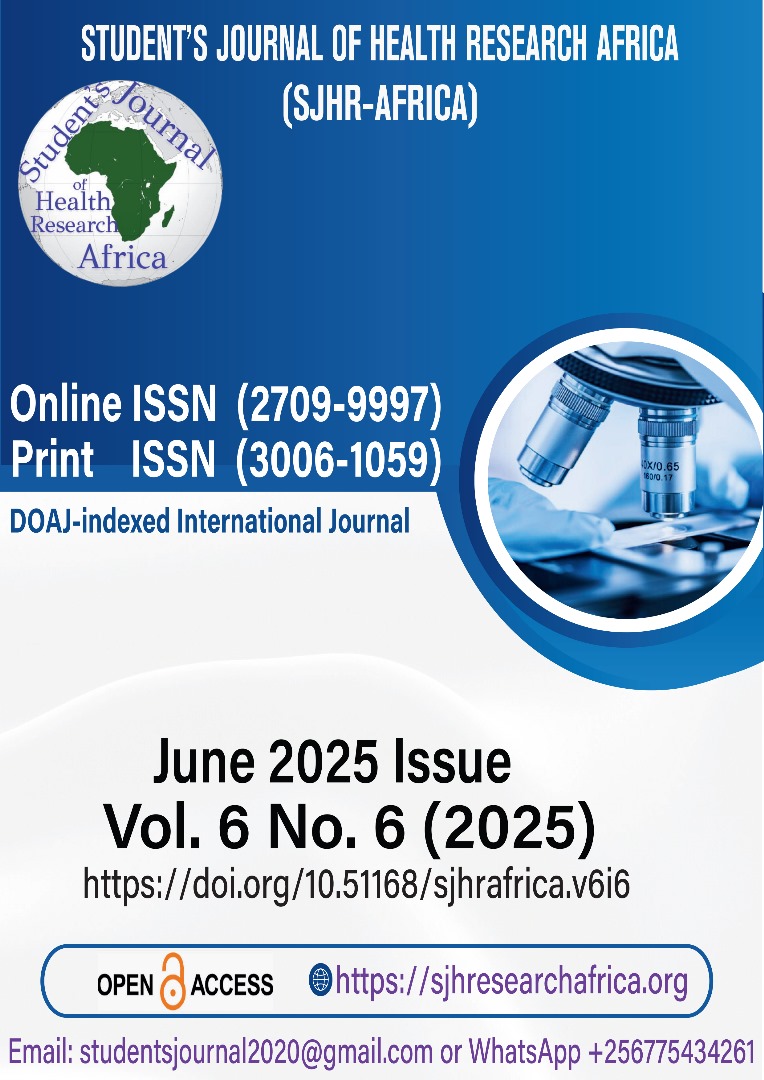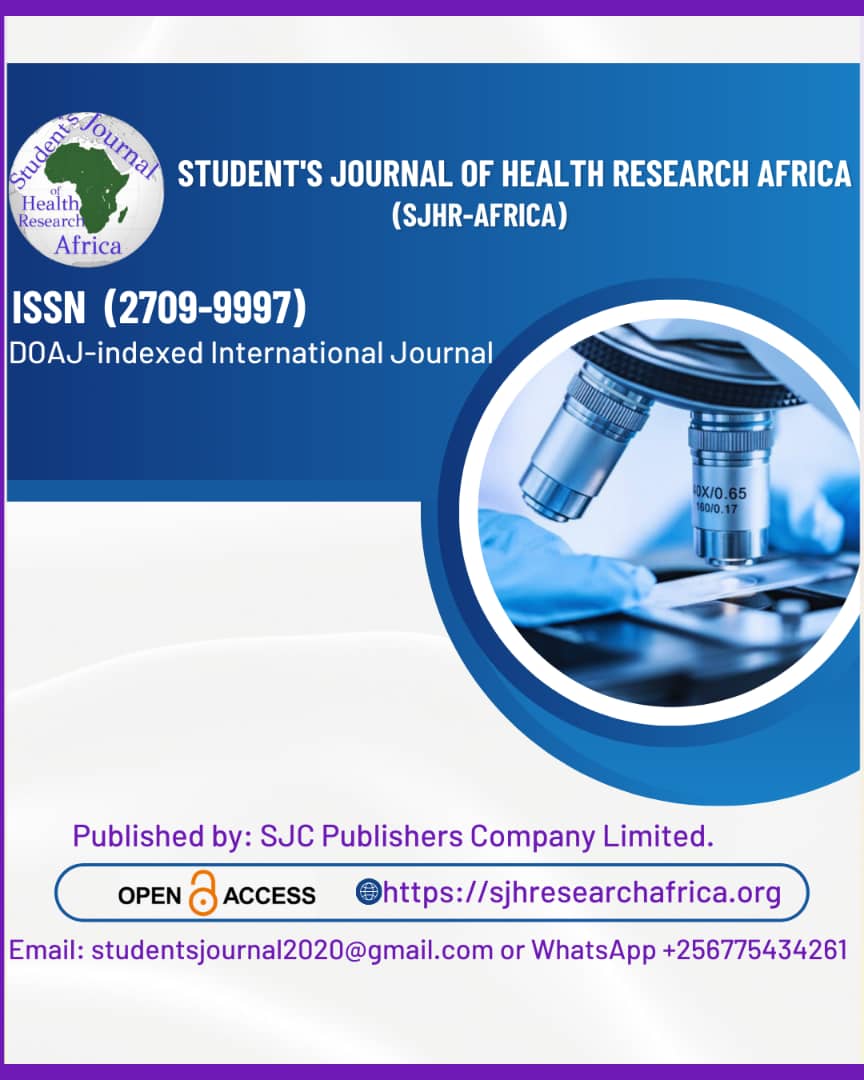AN IN VITRO EXPERIMENTAL STUDY ON THE ANTIMICROBIAL ACTIVITY OF SUTHERLANDIA FRUTESCENS ON PSEUDOMONAS AERUGINOSA.
Antimicrobial Activity of Sutherlandia frutescens on Pseudomonas aeruginosa
DOI:
https://doi.org/10.51168/sjhrafrica.v6i6.1720Keywords:
Sutherlandia frutescens, Pseudomonas aeruginosa, antimicrobial resistance, medicinal plants, Minimum Inhibitory Concentration (MIC)Abstract
Background
The increasing prevalence of antibiotic-resistant infections has prompted interest in medicinal plants such as Sutherlandia frutescens, traditionally used in Southern African medicine. Despite some evidence of antimicrobial properties, its efficacy against Pseudomonas aeruginosa remains unclear.
Aim: The study evaluates the antimicrobial activity of Sutherlandia frutescens extracts against P. aeruginosa, a multidrug-resistant nosocomial pathogen.
Methods
Aqueous and ethanol extracts of S. frutescens were prepared and tested using the modified Kirby-Bauer disc diffusion assay and broth microdilution for Minimum Inhibitory Concentration (MIC) determination.
Results
The aqueous extract of S. frutescens exhibited no inhibitory activity against P. aeruginosa. The ethanol extract displayed a MIC value of 1.56 mg/mL; however, this finding was inconclusive, as the ethanol control demonstrated equivalent inhibitory activity at the same concentration. Statistical analysis of the zones of inhibition revealed no significant difference between the ethanol extract and the ethanol control (p = 0.1315).
Conclusion
The study indicates that S. frutescens extracts possess negligible intrinsic antimicrobial activity against P. aeruginosa, lessening their potential as a standalone therapeutic option.
Recommendation
Future investigations should focus on evaluating synergistic interactions with conventional antibiotics or isolating specific bioactive compounds to enhance efficacy.
References
Anand, U., Jacobo-Herrera, N., Altemimi, A. and Lakhssassi, N., 2020. A comprehensive review on medicinal plants as antimicrobial therapeutics: Potential avenues of biocompatible drug discovery. Metabolites, 9(11), p.258. https://doi.org/10.3390/metabo9110258 PMid:31683833 PMCid:PMC6918160
Atanasov, A. G., et al. (2023). Natural products in drug discovery: Advances and opportunities. Nature Reviews Drug Discovery, 22(4), 247-270. doi:10.1038/s41573-023-00750-3
Barbieri, R., Coppo, E., Marchese, A., Daglia, M., Sobarzo-Sánchez, E., Nabavi, S.F. and Nabavi, S.M., 2017. Phytochemicals for human disease: An update on plant-derived compounds' antibacterial activity. Microbiological Research, 196, pp.44-68. https://doi.org/10.1016/j.micres.2016.12.003 PMid:28164790
Chukwuma, C. I., et al. (2022). Sutherlandia frutescens: A review on its traditional uses, phytochemistry, and pharmacology. Frontiers in Pharmacology, 13, 953834. doi:10.3389/fphar.2022.953834 https://doi.org/10.3389/fphar.2022.920823 PMid:35903345 PMCid:PMC9315951
Eloff, J.N., 1998. Which extractant should be used for the screening and isolation of antimicrobial components from plants? Journal of Ethnopharmacology,60(1), pp.1-8. https://doi.org/10.1016/S0378-8741(97)00123-2 PMid:9533426
Gellatly, S.L. and Hancock, R.E.W., 2023. Pseudomonas aeruginosa: New insights into pathogenesis and host defenses. Clinical Microbiology Reviews, 36(1), e00013-22. http://doi.org/10.1128/cmr.00013-22
Köhler, T., Perron, G.G., Buckling, A. and van Delden, C., 2024. Cefiderocol resistance in Pseudomonas aeruginosa: Emerging mechanisms and clinical implications. The Lancet Infectious Diseases, 24(3), pp e123-e137. https://doi.org/10.1016/S1473-3099(23)00652-1
Li, X.-Z., et al. (2023). Emerging resistance mechanisms in Pseudomonas aeruginosa: Implications for therapy. Drug Resistance Updates, 67, 100976. doi: 10.1016/j.drup.2023.100976 PMid:37210811
Ntuli, N. R., et al. (2023). Antimicrobial activity of Sutherlandia frutescens against clinically relevant pathogens. Journal of Ethnopharmacology, 301, 116456. doi: 10.1016/j.jep.2023.116456 PMid:37019158
Moyo, M., Aremu, A.O., Gruz, J., Šubrtová, M., Szüčová, L. and Doležal, K., 2023. Synergistic effects of Artemisia afra with β-lactams against ESBL-producing Enterobacteriaceae. Journal of Ethnopharmacology, 301, p.116789. https://doi.org/10.1016/j.jep.2022.116789
Pang, Z., et al. (2023). Biofilm-mediated infections by Pseudomonas aeruginosa: Challenges and advances in treatment. Nature Reviews Microbiology, 21(5), 347-362. doi:10.1038/s41579-023-00933-y PMid:37491458 PMCid:PMC12087466
Quave, C. L., & Horswill, A. R. (2023). Phytochemicals as antimicrobial adjuvants: Overcoming resistance. Clinical Microbiology Reviews, 36(2), e00102-22. doi:10.1128/CMR.00102-22
Tacconelli, E., Carrara, E., Savoldi, A., Kattula, D. and Burkert, F., 2024. Global priority list of antibiotic-resistant Pseudomonas aeruginosa high-risk clones. Nature Reviews Microbiology, 22(2), pp.102-115. https://doi.org/10.1038/s41579-023-00986-9
Van Wyk, B.E., Oudtshoorn, B.V. and Gericke, N., 2023. Seasonal variation in the phytochemistry of Sutherlandia frutescens: Implications for quality control. South African Journal of Botany, 144, pp.319-327. https://doi.org/10.1016/j.sajb.2022.09.041
World Health Organization. (2024). Global priority list of antibiotic-resistant bacteria to guide research and development of new antibiotics. Bulletin of the World Health Organization, 102(1), 1-12. doi:10.2471/BLT.23.290874
Downloads
Published
How to Cite
Issue
Section
License
Copyright (c) 2025 Nhlanhla Nsele, Nontobeko Ndlovu

This work is licensed under a Creative Commons Attribution-NonCommercial-NoDerivatives 4.0 International License.






















